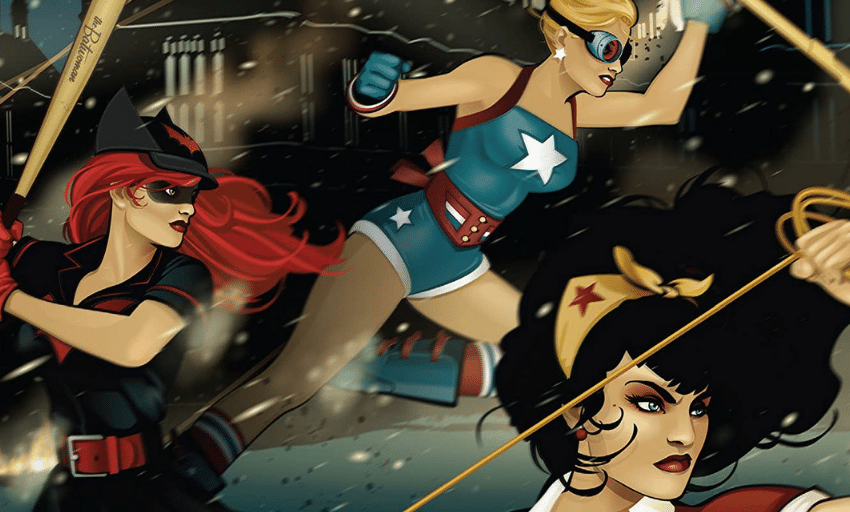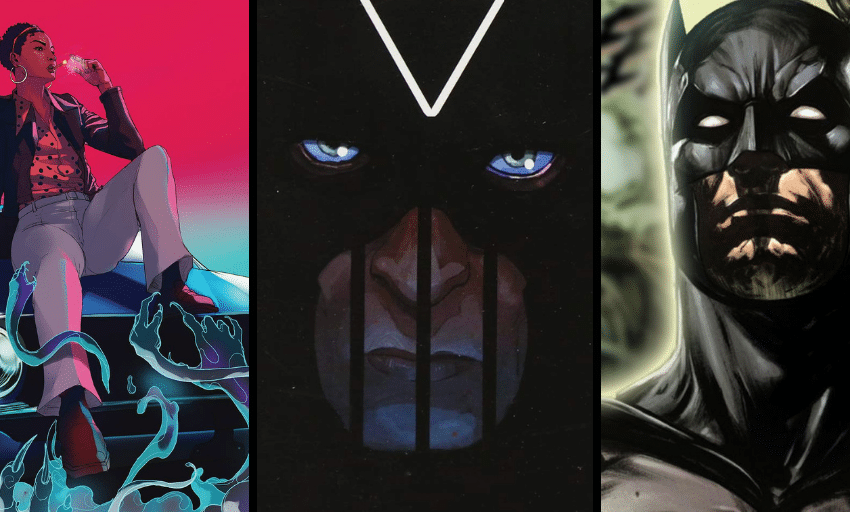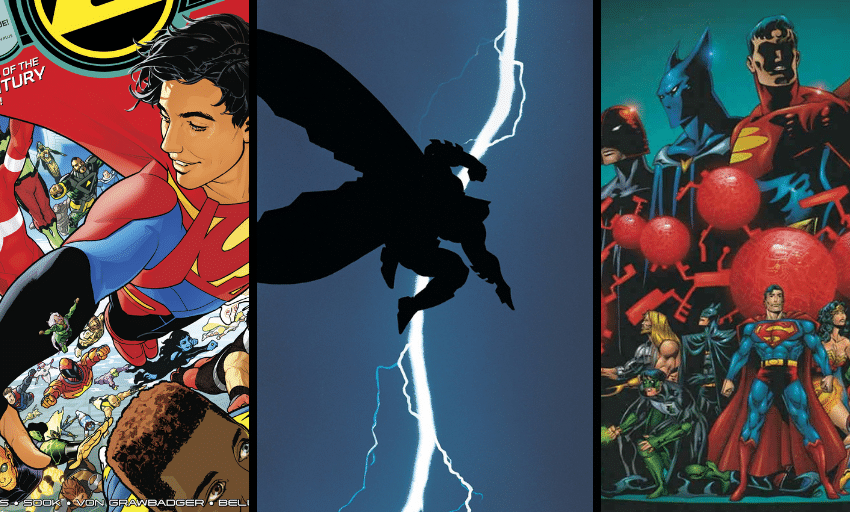Robin is the greatest sidekick in comic history. Whether it’s the acrobatic joy of Dick Grayson, the angry young man that is Jason Todd, the brilliant mind of Tim Drake, or the snark and skill of Damian Wayne, Robin brings something to every Batman story. This week’s tie-in to DC’s ongoing “Dark Nights: Death Metal” event focuses on another Robin: the young evil Bruce Wayne called The Robin King. So for this week’s Bonus Reading, we’ll be looking at four other alternate takes on the Boy Wonder.
Carrie Kelley

The best known non-canonical Robin is, with little doubt, Carrie Kelley, the Robin of the universe of “The Dark Knight Returns.” Created by Frank Miller, Carrie was the first female Robin and has appeared throughout the entire Millerverse, evolving from Robin to Catgirl to Batwoman.
Carrie first appears in the first issue of “The Dark Knight Returns,” where Batman saves her from members of the Mutants gang. Inspired, Carrie buys herself a Robin costume, sneaks out of her home (her parents are apathetic dropouts who barely know she exists), and seeks out Batman to become his partner. Batman accepts Carrie as his new partner after she pulls him from the clutches of the Mutant Leader, and she supports him through his entire campaign to save Gotham, and aids in his final battle with Superman. I could sum up more, but most of you out there have read “Dark Knight Returns,” and if you haven’t, it feels like you’re making a conscious choice and I respect that.
Carrie would continue as Batman’s right-hand woman throughout the remainder of Miller’s “Dark Knight” stories. In “Dark Knight Strikes Again,” she takes on the identity of Catgirl and is hunted by the warped and insane Dick Grayson. She takes on an even more active role as Batgirl and then Batwoman in “Dark Knight III: The Master Race,” where she fights Kryptonians.
Your appreciation of the character may vary based on your feelings about Miller and his work, and that is more than fair. But Miller gets the idea of what a Robin is supposed to be very right in his creation of Carrie. She is the lightness to the very Dark Knight, reminding him of the good in people and humanity.
Aside from those stories, Carrie has appeared in the regular DC continuity in recent years. She was introduced in the New 52’s “Batman and Robin” #19 as a college student tutor of Damian Wayne’s, who sought him out after he suddenly “went to school in Europe” — he was dead at the time, but he got better. Bruce meets her at a costume party where she is, of course, dressed as Robin. She was meant to have a larger role in the series, and when the book was changed to a team-up book during Damian’s death, was meant to co-star in issue #25, but the book was changed from its solicited content, and Carrie was never seen again. Speculation was this was due to Miller signing a contract to return for “Dark Knight III,” but I have been unable to find confirmation on that. Still, Carrie is out there, and made a cameo as recently as a flash forward in the Rebirth-era “Batman Annual” #2, so it’s only a matter of time before she returns.
Bruce Wayne

The Robin King is not the first time Bruce Wayne has donned a Robin costume. Pre-Crisis Batman continuity is wild, you see. Everything was connected. Thomas Wayne was the first Batman, having worn a Batman-type costume to a party that would later inspire Bruce. And Bruce, during his training, became the first Robin.
When Bruce was looking to train as a detective, he found a well-known detective named Harvey Harris whom he wanted to train under, but he needed to protect his identity. So Bruce came up with a costumed identity — that of Robin. And though Harris saw through it, he didn’t reveal that to Bruce until after his passing.
This is a weird little bit of retconning, and obviously doesn’t work in any continuity after the Golden into Silver Age. The original version of the story was told in “Detective Comics” #226, which was less than a year before the Thomas Wayne retcon I mentioned at the beginning of this section; adding to Batman’s history was all the rage in the mid-1950s, apparently. The story was kept in continuity in “The Untold Legend of Batman,” the miniseries that was released to tell a streamlined version of Batman’s history … only to be wiped out a few short years later by “Crisis on Infinite Earths.” The Bruce Wayne-as-Robin thing might have disappeared, but fortunately Harvey Harris survived the Crisis, appearing as one of Batman’s teachers in a Mark Waid/Brian Augustyn story in “Detective Comics” Annual #2.
Robin the Toy Wonder

“DC One Million” is one of the best crossovers in DC history. Grant Morrison helped shape an entirely new far future for the DC Universe, filled with fascinating takes on classic heroes. One of the most visually unique had to be Robin the Toy Wonder, sidekick to Batman One Million.
The Robin of the 853rd century is not a biological entity but a robot, programmed with the perky personality of a young child. Robin was built to serve as the conscience for the dark Batman of the era, who was the warden of the prison planet of Pluto. Robin, as with previous Robins, helps balance out Batman’s darker instincts.
Robin the Toy Wonder appears on Pluto during the crossover, where he is trapped on the planet along with a time-displaced Bruce Wayne, when all the cells are opened and the villains overrun the planet. He is badly damaged but proves he is a hero, staying functional long enough to aid Bruce in escaping the world to allow him to find his way back to the present. The design of the character is so striking that despite only a few brief appearances in the crossover, Robin the Toy Wonder has popped up in most returns to the 853rd century, and a version appears in the present in the New Age of Heroes series “The Unexpected.”
The Protector

Oh, licensing agreements. Back in the heyday of the New Teen Titans, DC worked with cookie company Keebler to do a series of New Teen Titans comics to raise awareness of drug abuse. But Robin, a principal member of the Titans, was already involved in a Batman-related license with another cookie company, Nabisco. And so writer Marv Wolfman needed to find a character to replace Robin. Thus the Protector was born.
This would have been the beginning and end of this oddball little character, who wore a purple and red costume and was pretty much a color-swapped Robin, except DC in the ’80s never did anything in half measures. Oh no. Protector got a “Who’s Who in the DC Universe” entry where it was revealed he was Jason Hart, a young man who sought to fight drug dealers after his cousin became an addict. Drawing the attention of Nightwing, Dick Grayson made him an honorary Titan and trained him to help his fight against crime.
Protector would pop up in various Titans crowd scenes but appeared very infrequently. He was one of the heroes at the superhero trauma facility called Sanctuary during “Heroes in Crisis,” where he revealed he had a drug problem before dying. Alas, Protector, we hardly knew ye.
Matt Lazorwitz read his first comic at the age of five. It was Who's Who in the DC Universe #2, featuring characters whose names begin with B, which explains so much about his Batman obsession. He writes about comics he loves, and co-hosts the creator interview podcast WMQ&A with Dan Grote.






